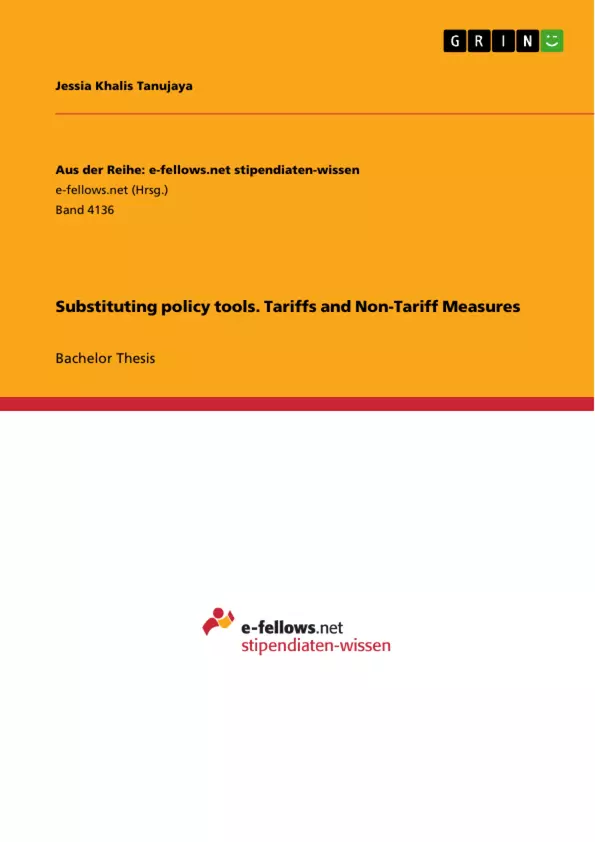This paper aims to analyze the substitution relationship between the two policy tools: tariffs and non-tariff measures. The empirical part will also compare the substitutability among developed and developing countries, as well as among various industries in an economy. The role of tariff binding overhang as a mediator that influences how non-tariff measures are used in place of tariffs will also be discussed.
Lastly, an outlook on the global progress towards free trade will inevitably have an impact on the wider health and environmental aspects. Therefore, the last part of this paper will discuss how the substitution of tariffs to NTMs can link to these broader dimensions, as well as what additional changes are necessary to ensure that a country’s economic goal aligns with its aim towards environmental protection.
Inhaltsverzeichnis (Table of Contents)
- Introduction
- Theoretical Part
- The Standard Trade Model
- Tariffs
- Non-Tariff Measures (NTMs)
- Tariffs-NTMs Relationship
- Empirical Part
- Comparison Across Countries
- Comparison Across Industries
- Tariff Binding Overhang
- Health and Environmental Discussion
- Conclusion and Implication
- References
Zielsetzung und Themenschwerpunkte (Objectives and Key Themes)
This bachelor thesis explores the relationship between tariffs and non-tariff measures (NTMs) as trade policy tools. It investigates how these tools substitute each other, focusing on the context of global trade liberalization. The study examines the substitutability of tariffs and NTMs across different countries and industries, analyzing the role of tariff binding overhang in mediating the relationship between these tools. The research also delves into the broader implications of this substitution for health and environmental aspects, considering the impact of trade policies on global sustainability.
- Substitutability of tariffs and non-tariff measures (NTMs)
- Comparative analysis across countries and industries
- Role of tariff binding overhang in mediating the relationship between tariffs and NTMs
- Implications for health and environmental aspects
- Impact of trade policies on global sustainability
Zusammenfassung der Kapitel (Chapter Summaries)
- Introduction: This chapter sets the context by discussing the increasing trend towards global free trade and the continued use of protectionist measures like tariffs and NTMs. It highlights the importance of understanding the relationship between these policy tools, particularly as tariffs have been declining while NTMs have become more prevalent.
- Theoretical Part:
- The Standard Trade Model: This section introduces the standard trade model as a framework for analyzing trade policy tools, highlighting its advantages over other models. It describes the key assumptions of the model, including the existence of two goods, two production factors, and two countries, and explains how these assumptions lead to differences in production possibility frontiers.
- Tariffs: This section discusses tariffs as a trade policy tool, explaining their impact on prices, production, and consumption. It explores the effects of specific tariffs in large and small countries, analyzing the potential for welfare gains and losses.
- Non-Tariff Measures (NTMs): This section provides an overview of NTMs, exploring their diverse forms and the reasons for their implementation. It discusses the different categories of NTMs, including sanitary and phytosanitary standards (SPS), technical barriers to trade (TBT), and other regulations.
- Tariffs-NTMs Relationship: This section examines the relationship between tariffs and NTMs, analyzing how they interact and potentially substitute for each other. It discusses the factors that may influence the substitutability of these tools and explores the implications for trade policies.
- Empirical Part:
- Comparison Across Countries: This chapter presents empirical evidence on the substitutability between tariffs and NTMs across different countries. It analyzes data on average NTMs and tariffs in developed and developing countries, examining the extent to which these tools are used in combination.
- Comparison Across Industries: This chapter explores the substitutability between tariffs and NTMs across different industries. It analyzes data on the use of tariffs and NTMs in various sectors, examining the factors that may influence their adoption.
- Tariff Binding Overhang: This chapter focuses on the role of tariff binding overhang as a mediator in the relationship between tariffs and NTMs. It investigates how the potential for tariff increases affects the use of NTMs as substitutes.
Schlüsselwörter (Keywords)
This research focuses on the intersection of international trade, trade policy, and global economics. Key terms include tariffs, non-tariff measures (NTMs), trade liberalization, substitutability, tariff binding overhang, World Trade Organization (WTO), and sustainability.
- Citation du texte
- Jessia Khalis Tanujaya (Auteur), 2021, Substituting policy tools. Tariffs and Non-Tariff Measures, Munich, GRIN Verlag, https://www.grin.com/document/1196294



